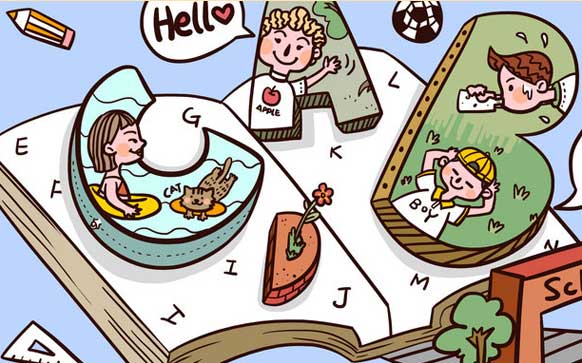Title: The Wonders of English through Art
Introduction: Art, a universal language that transcends borders, cultures, languages, and eras. It has the power to evoke emotions, tell stories, and convey meaning. English, the most widely spoken language in the world, is also an art form in its own right. From poetry to prose, painting to sculpture, it has countless forms that can be expressed through the brush or canvas. In this article, we will explore how English is represented through art and the unique ways in which it can be learned. Art and English: A Visual Dictionary Art is often seen as a visual dictionary that translates into words on canvas, paper, or screen. For example, a painting by Claude Monet titled "Water Lilies" depicts a pond with vibrant hues, symbolizing the joy and beauty of summer. The painting's colors and composition are translated into the English words "lilies," which represent the flowers in the scene. Similarly, a poem by William Blake titled "The Tyger" uses symbols to convey abstract concepts about nature and freedom. The English words "tiger," "nature," and "freedom" reflect the essence of the poem's meaning. English Paintings and Their Meanings English paintings often use symbolism to communicate deeper messages. One famous example is "The Scream," by Edouard Manet, which depicts a woman screaming at her child. The painting's title itself is translated into English as "scream," which represents the woman's pain and despair. Another painting by Vincent van Gogh titled "Starry Night" uses night sky patterns to represent the artist's struggles and dreams. The English words "night," "sky," and "dreams" capture the mood and themes of the painting. English Sculptures and Their Meanings English sculptures also convey meaning through their shapes and textures. One example is "The Thinker," by Auguste Rodin, which depicts a man contemplating something deeply. The English translation of "the thinker" is "think," which refers to the man's mental activity. Similarly, "The Thinker" translates to "think," highlighting the importance of mind in the sculpture's theme. English Poems and Their Rhymes English poetry often uses rhythm and rhyme to express emotions and ideas. A famous example is "Ode to Joy," written by Samuel Taylor Coleridge. The poem's rhythm and rhyme structure create a sense of harmony and balance, symbolizing the beauty and peace found in nature. The English words "joy," "nature," and "balance" reflect the poem's message of unity and serenity. Learning English through Art Learning English through art can be a fun and engaging experience. Artists often use English words in their works to create visual narratives that can be appreciated by non-native speakers. By studying these artworks, one can gain insights into English grammar, vocabulary, and idiomatic expressions. Additionally, art galleries and museums often display English-language works, making it easy to find examples of English usage in different contexts. Conclusion: Art and English: A Unique Bond Art is a powerful medium that can convey complex meanings using simple language. English, as a language with a rich history and culture, has been incorporated into many artistic forms throughout the centuries. By exploring art, one can deepen their understanding of English, learn new words, and appreciate the beauty of language and creativity. Whether it's looking at paintings, reading poetry, or watching plays, every piece of art has a story to tell and a way to teach us about English. So let your eyes wander across the canvas or scroll through the pages of a novel and discover the wonders of English through art. 推荐阅读》
 家长点评网
家长点评网











